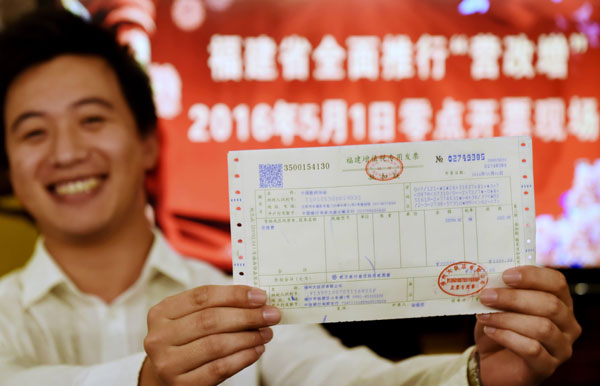China completes implementation of VAT scheme
Xinhua, May 3, 2016 Adjust font size:
 |
|
Guest Xie Ping shows his value-added tax (VAT) invoice offered by Fuzhou Hotel in Fuzhou, southeast China's Fujian Province, May 1, 2016.[Photo/Xinhua] |
China has replaced all business tax with value-added tax (VAT) after extending the policy to cover the construction, real estate, finance and consumer services sectors on Sunday.
They were the last four sectors still taxed based on their revenue.
VAT refers to a tax levied on the difference between a commodity's price before taxes and its production cost. Revenue tax refers to a levy on a business's gross revenues.
The expansion of the VAT scheme is expected to ease tax burdens by more than 500 billion yuan (76.9 billion U.S. dollars) this year.
China's service sector is increasingly picking up the slack of manufacturing as the world's second-largest economy is shifting towards a more sustainable growth driven chiefly by consumer demand.
Expanding VAT to more service sectors is also part of the supply-side structural reforms authorities have been promising since last year to address the structural imbalances in the Chinese economy.
"We now have to pay an 11-percent value-added tax compared with 5.5 percent business tax in the past. It appeared that the tax rate had increased but the base on which the tax is collected has shrank so ultimately our tax burden is reduced," said a treasurer with a construction firm in the northern Chinese city Tianjin.
The VAT scheme first started in 2012 as a pilot program in Shanghai, covering a number of services including transportation, IT, and logistics. It was later expanded nationwide and to cover other businesses.
Over the past four years, the VAT scheme has saved 640 billion yuan in taxes for businesses.